How to Find a Water Leak in Your House

How to Find a Water Leak in Your House
An undiscovered leak in your home’s water supply could end up costing you hundreds of dollars a month, or even result in severe damage to the structure of your living space. Fortunately, it’s pretty easy to pinpoint the source of many leaks and save yourself a considerable chunk of change, provided you know what to look for. If you think you might have a leak but haven’t yet received a notice from your local utilities board, your best bet is to check common problem areas for tell-tale signs of escaping water, such as drips, moisture damage, or noisy pipes.
Checking Indoor Appliances and Fixtures
-
 1Watch for changes in your water meter to confirm that you have a leak. Before you do anything else, shut off the main water supply to your home and take a close look at your water meter. If either the normal or low-flow indicator hand is moving, it means you have a continuous leak somewhere in the line. On newer digital meters, the tipoff will be seeing any number other than “0” on the flow rate screen.
1Watch for changes in your water meter to confirm that you have a leak. Before you do anything else, shut off the main water supply to your home and take a close look at your water meter. If either the normal or low-flow indicator hand is moving, it means you have a continuous leak somewhere in the line. On newer digital meters, the tipoff will be seeing any number other than “0” on the flow rate screen.- All homes are equipped with water meters designed to simplify billing and help homeowners keep track of how much water they’re using on a regular basis. In most cases, your water meter will be in a protective “box” near the curb or sidewalk in front of your home.
- Minor leaks may not create enough lost water to show up on your water meter right away. To be absolutely sure, wait 1-2 hours after your initial reading and take a second one. If the second reading differs from the first, you’ve got a leak.
-
 2Eyeball the pressure relief and drain valves on your hot water heater. Once you’ve determined that you’ve got a leak on your hands, it’s time to locate it. Start by heading to your hot water heater and looking for pooling on the surrounding floor. If the cause is a dripping valve, it probably just needs to be replaced. If the valves are dry, there’s a chance that the leak is inside the tank, which means you may need a brand new water heater.
2Eyeball the pressure relief and drain valves on your hot water heater. Once you’ve determined that you’ve got a leak on your hands, it’s time to locate it. Start by heading to your hot water heater and looking for pooling on the surrounding floor. If the cause is a dripping valve, it probably just needs to be replaced. If the valves are dry, there’s a chance that the leak is inside the tank, which means you may need a brand new water heater.- You’ll find the pressure relief and drain valves at the top and bottom of your water heater, respectively.
- Listen closely for dripping, gurgling, or hissing sounds, as well. It’s possible that your leak hasn’t yet manifested visibly on the outside of the water heater, but it may still be detectable audibly.
-
 3Examine each of the toilets in your home. Add a few drops of dark food coloring to the toilet’s tank, then wait half an hour or so without flushing the toilet. After that time, look to see if the dye has made its way into the bowl. Assuming it has, the problem is most likely a worn-out flapper valve. However, a bad flush handle may also be the culprit. Your next step is to identify which component is to blame and pick up a replacement at your local hardware store.
3Examine each of the toilets in your home. Add a few drops of dark food coloring to the toilet’s tank, then wait half an hour or so without flushing the toilet. After that time, look to see if the dye has made its way into the bowl. Assuming it has, the problem is most likely a worn-out flapper valve. However, a bad flush handle may also be the culprit. Your next step is to identify which component is to blame and pick up a replacement at your local hardware store.- The majority of toilet leaks originate at the flapper valve, which is the rubber seal that moves up and down when you flush the toilet. You’ll often hear the water running continuously if the flapper valve isn’t sealing properly.
- If you think the flush handle might be the problem, try tightening the nut securing it to the side of the tank or adjusting the length of the chain so that it’s neither too taut nor too loose. If neither of these solutions work, you may need to replace the handle altogether.
Tip: Be sure to repeat this process for every toilet in your home individually to narrow down the source of the issue.
-
 4Look for leaky shower heads and drains. While you’re in the bathroom, take a peek inside the shower. Spotted pooling is usually due to a partially-open curtain or sliding door that’s off alignment, but in some cases, it may be the result of a dripping shower head, broken tile, or loose drain connection. Re-seal or replace these at your earliest convenience to prevent the need for more serious repairs later on.
4Look for leaky shower heads and drains. While you’re in the bathroom, take a peek inside the shower. Spotted pooling is usually due to a partially-open curtain or sliding door that’s off alignment, but in some cases, it may be the result of a dripping shower head, broken tile, or loose drain connection. Re-seal or replace these at your earliest convenience to prevent the need for more serious repairs later on.- You can test your shower’s drain by covering it with a test plug, running 1–2 inches (2.5–5.1 cm) of water into the basin and waiting to see if the water level goes down inexplicably. Failing sealants can allow water to escape around the edges of the drain.
- In rare cases, structural damage to the walls or floor underlying the shower stall may be behind the leak. If caulking problem areas doesn’t fix things, these types of leaks may require professional intervention.
-
Pay attention to evidence of water damage around sinks and faucets. If you’re lucky, you’ll be able to spot the source of the leak with your own eyes. Otherwise, look for water stains, swelling, or rotting in the surrounding wood or particle board. Tightening the faucet base, replacing cracked handle or knob valves, or scraping away and applying new waterproof caulk around fixtures will remedy most small-scale point leaks.
- Here’s a helpful experiment if you can see water but aren’t sure where it’s coming from: pour out a large glass of water all around the sink basin, including the countertop. Then, open the cabinet beneath the sink and watch for it to dribble out from unseen cracks or holes.
Detecting Leaks Outside
-
 1Go around and inspect your home’s exterior hose bibbs. The “bibbs” are the faucet-like pipes on the side of your home that you use to hook up a watering hose. These may be actively dripping, or they may hiss or vibrate faintly as water passes through. 9 times out of 10, you can stop a leaky bibb by tightening the packing nut that secures the handle or replacing a worn out washer inside the handle assembly. If neither of these solutions work, call a plumber and have them trace the leak further back into […]
1Go around and inspect your home’s exterior hose bibbs. The “bibbs” are the faucet-like pipes on the side of your home that you use to hook up a watering hose. These may be actively dripping, or they may hiss or vibrate faintly as water passes through. 9 times out of 10, you can stop a leaky bibb by tightening the packing nut that secures the handle or replacing a worn out washer inside the handle assembly. If neither of these solutions work, call a plumber and have them trace the leak further back into […]
# # #
Continue to read this article.
Don’t forget, The Portier Agency offers:
homeowner/mobile home/ renter’s /automobile / motorcycle / life / commercial / crop insurance.
Call or come by to get your quote!
 The Portier Agency, LLC
The Portier Agency, LLC
113 North Irwin Avenue
Ocilla, GA 31774
229-468-3444
portieragency@windstream.net




